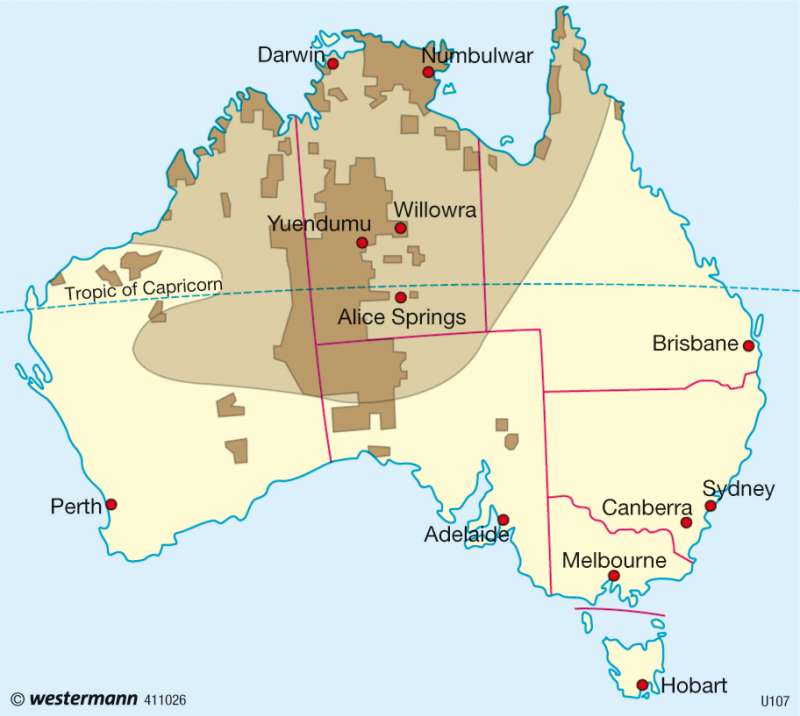Original inhabitants (Aborigines)
Australia and New Zealand
978-3-14-100790-9 | Page 121 | Ill. 5

Information
The map shows the living areas of the Aborigines. However, the economics of indigenous conflicts are indicated by the inclusion and occurrence of important mineral resources and unusable agricultural land.The situation of the indigenous people (Aborigines)
The exact origin of the native Australians is unknown although they probably migrated from about 60,000 years ago during the glacial sea-level lowering of the Malay Archipelago. The natives lived under the region's natural conditions, as hunter-gatherers. Official sources speak of 500 different nations with 250 languages and some 700 dialects. The boomerang was not known as a hunting weapon of all of these peoples.
The settlement by whites began a rapid decimation of the indigenous people through expulsion, massacre and disease, against which, the Aborigines had developed no immunity. Up to the late 18th Century, about 300,000 inhabitants were most likely still on the continent, until the middle of the 19th Century, when numbers decreased to fewer than 100,000.
In the census of 1996, the numbers of descendants of indigenous people were counted at 353,000, mostly Aboriginal. A small minority were not related to the indigenous Torres Strait Islanders who lived mainly in northern Queensland in the Torres Strait and who greatly influenced Melanesian culture. In 2005, the indigenous population was at 2.2 percent of the total population of just over 20 million Australians. Exact figures did not appear until 1967, when the Aborigines were treated, in the course of a constitutional amendment, the same as all other Australians. The term Aboriginal has since become applicable to whoever describes himself as such.
Awareness that the indigenous people had needs and rights only developed among white Australians in the 1970's. Adopted in 1976, the "Land Rights Act" was first awarded to the descendants of Native Australians in property rights. Prior to this Act, they were either forced back into reserves or mission stations such as the German Hermannsburg Mission, which were set up around 1877. Only in 1992, did the High Court acknowledge that black Australians have ownership of land to which they have maintained traditional ties (Mabo case). Meanwhile, their property rights have been transferred to rural areas with far-reaching self-government (land councils) under the supervision of the Federal Government. The best known examples are the Uluru National Park (Ayers Rock) and Kakadu National Park which secure the leases from Aboriginal tourism revenues. Similar agreements exist with mining companies. However, since the majority of Aboriginal people live far away in the large cities and other densely populated areas, only a few Native Australians benefit from land rights, while many of them still suffer economic and social deprivation. This is manifested, among other things, in the fact that a disproportionately large number of Aboriginal Australians are among the poor and unemployed, and the infant mortality rate for Aboriginal people is twice that of the white population.
Since 2007, the Aboriginal land rights have once again been applied to rain forests on Australia's east coast, among them several national parks.
W. Maresch; Ü: Colette Flemin




